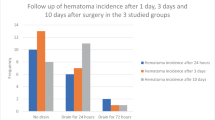Abstract
Infection is a devastating complication of penile prosthesis surgery that occurs in approximately 2–5% of all primary inflatable penile primary implants in most series. Prevention of hematoma and swelling with closed-suction drains has been shown not to increase infection rate and yield an earlier recovery time. Despite the intuitive advantages of short-term closed-suction drainage in reducing the incidence of postoperative scrotal swelling and associated adverse effects, many urologists are reluctant to drain the scrotum because of a theoretical risk of introducing an infection. In conclusion, this study was undertaken to evaluate the incidence of infection in three-piece penile prosthesis surgery with scrotal closed-suction drainage. A retrospective review of 425 consecutive primary three-piece penile prosthesis implantations was performed at three institutions in New Jersey, Ohio, and Arkansas from 1998 to 2002. Following the prosthesis insertion, 10 French Round Blake (Johnson & Johnson) or, in a few cases, 10 French Jackson Pratt, closed-suction drains were placed in each patient for less than 24 h. All subjects received standard perioperative antibiotic coverage. Average age at implant was 62 y (range 24–92 y). Operative time (incision to skin closure) was less than 60 min in the vast majority of cases. There were a total of 14 (3.3%) infections and three hematomas (0.7%) during an average 18-month follow-up period. In conclusion, this investigation revealed that closed-suction drainage of the scrotum for approximately 12–24 h following three-piece inflatable penile prosthesis surgery does not result in increased infection rate and is associated with a very low incidence of postoperative hematoma formation, swelling, and ecchymosis.
This is a preview of subscription content, access via your institution
Access options
Subscribe to this journal
Receive 8 print issues and online access
$259.00 per year
only $32.38 per issue
Buy this article
- Purchase on Springer Link
- Instant access to full article PDF
Prices may be subject to local taxes which are calculated during checkout
Similar content being viewed by others
References
Magee C et al. Potentiation of wound infection by surgical drains. Am J Surg 1976; 131: 547–549.
Montague DK . Periprosthetic infections. J Urol 1987; 138: 68–69.
Montague DK, Angermeier KW, Lakin MM . Penile prosthesis infections. Int J Impot Res 2001; 13: 326–328.
Sadeghi-Nejad H, Seftel A . Vacuum devices and penile implants. In: Male and Female Sexual Dysfunction. Elsevier/Mosby: St Louis, Missouri, 2004.
McClellan DS, Masih BK . Gangrene of the penis as a complication of penile prosthesis. J Urol 1985; 133: 862–863.
Saleh K et al. Predictors of wound infection in hip and knee joint replacement: results from a 20 year surveillance program. J Orthop Res 2002; 20: 506–515.
Morris AM . A controlled trial of closed wound suction. Br J Surg 1973; 60: 357–359.
Kim YH, Cho SH, Kim RS . Drainage versus nondrainage in simultaneous bilateral total hip arthroplasties. J Arthroplasty 1998; 13: 156–161.
Kim YH, Cho SH, Kim RS . Drainage versus nondrainage in simultaneous bilateral total knee arthroplasties. Clin Orthop Relat Res 1998; Feb (347): 188–193.
Parker MJ, Roberts C . Closed suction surgical wound drainage after orthopaedic surgery. Cochrane Database Syst Rev 2001; 4: CD001825.
Carson Jr CC . Efficacy of antibiotic impregnation of inflatable penile prostheses in decreasing infection in original implants. J Urol 2004; 171: 1611–1614.
Garber BB . Mentor Alpha 1 inflatable penile prosthesis: patient satisfaction and device reliability. Urology 1994; 43: 214–217.
Wilson S, Cleves M, Delk JI . Hematoma formation following penile prosthesis implantation: to drain or not to drain. J Urol 1996; 55: 634A.
Raves JJ, Slifkin M, Diamond DL . A bacteriologic study comparing closed suction and simple conduit drainage. Am J Surg 1984; 148: 618–620.
Carson CC . Infections in genitourinary prostheses. Urol Clin North Am 1989; 16: 139–147.
Abouassaly R, Montague DK, Angermeier KW . Antibiotic-coated medical devices: with an emphasis on inflatable penile prosthesis. Asian J Androl 2004; 6: 249–257.
Soriano A et al. Treatment of acute infection of total or partial hip arthroplasty with debridement and oral chemotherapy. Med Clin (Barc) 2003; 121: 81–85.
Von Eiff C, Peters G, Heilmann C . Pathogenesis of infections due to coagulase-negative staphylococci. Lancet Infect Dis 2002; 2: 677–685.
Author information
Authors and Affiliations
Corresponding author
Rights and permissions
About this article
Cite this article
Sadeghi-Nejad, H., Ilbeigi, P., Wilson, S. et al. Multi-institutional outcome study on the efficacy of closed-suction drainage of the scrotum in three-piece inflatable penile prosthesis surgery. Int J Impot Res 17, 535–538 (2005). https://doi.org/10.1038/sj.ijir.3901354
Received:
Revised:
Accepted:
Published:
Issue Date:
DOI: https://doi.org/10.1038/sj.ijir.3901354
Keywords
This article is cited by
-
Value of prolonged scrotal drainage after penile prosthesis implantation: a multicenter prospective nonrandomized pilot study
International Journal of Impotence Research (2023)
-
Commentary: Value of prolonged scrotal drainage after penile prosthesis implantation: a multicentre prospective nonrandomized pilot study
International Journal of Impotence Research (2023)
-
History of penile implants: from implants made of bone to modern inflatable penile implants
International Journal of Impotence Research (2023)
-
The International Penile Prosthesis Implant Consensus Forum: clinical recommendations and surgical principles on the inflatable 3-piece penile prosthesis implant
Nature Reviews Urology (2022)
-
Unexpected nuances of the penoscrotal inflatable penile prosthesis
International Journal of Impotence Research (2022)



